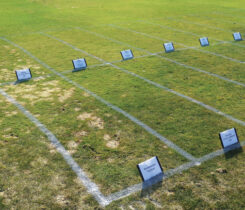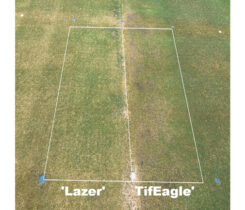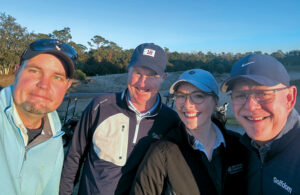Off the Record: Evaluating winter injury on annual bluegrass greens
Extensive winterkill of annual bluegrass (Poa annua) golf greens is a major problem in northern climates. In a three-year (1993 to 1996) field study at Laval University and Montreal Country Club, Canada, researchers conducted research on covers to protect annual bluegrass greens from winter damage.

Mike Kenna, Ph. D.
Julie Dionne, a graduate student under Yves Desjardins, Ph.D., documented the environmental conditions under protective covers at the turf crown level and 4- and 8-inch depths.
Treatments included permeable and impermeable covers, curled wood shavings mat, straw mulch protected by an impermeable cover, geotextile material with an impermeable cover and 4-inch air space under an impermeable cover compared to a control treatment. Results showed the influence on the temperature profile of winter protection covers and snow depth. Temperatures at crown level were stable and just below 0 degrees C under plots with significant snow. However, temperatures varied considerably when snow cover was less than 6 inches.
The insulating material covers (curled wood mat, air space and straw) reduced soil temperature variation ranges, minimized the impact of freezing air temperature and thin snow cover, and consequently enhanced the winter survival of golf greens under thin snow cover.
Temperature profiles were comparable for 4-inch air space treatments and were not significantly different from impermeable covers spread directly on the turf. Straw with an impermeable cover and wood shaving mats maintained crown temperatures at more than 0 degrees C and disease incidence was higher under these materials.
Thus, depending on local conditions, and particularly on snow cover, the characteristics of specific protective covers can influence golf green soil temperatures and turfgrass survival during the overwintering period.
In 1994, David Huff, Ph.D., joined the Department of Crop and Soil Sciences at Penn State. In 1998, he received a grant from the USGA Davis Research Program to develop annual bluegrass cultivars for greens.
Huff, with the help of USGA Green Section agronomists, collected more than 2,500 samples of greens-type Poa annua from regions including the northeast U.S. (Pennsylvania, New Jersey, New York), the mid-Atlantic (Delaware, Maryland, Virginia) and the Pacific Northwest (Oregon and Washington). The performance and variation were tremendous.
In a 2010 peer-reviewed article, Dionne, Huff and their collaborators evaluated 42 Poa ecotypes from Canada and the U.S. They analyzed cold-induced biochemical changes in a subset of ecotypes with varied tolerance to winter injury. There was an extensive range of variability among the ecotypes for freezing tolerance expressed as the lethal temperature for 50 percent of the plants (LT50) with values ranging from < -27 to -17 degrees C (-16 to 2 degrees F).
Ecotypes from Québec, better insulated from extreme subfreezing temperatures by reliable and abundant snow cover, developed less freezing tolerance than those evolving under milder winter climates in the U.S. They observed differences in concentrations of specific amino acids and carbohydrates among ecotypes.
However, only fructans of high molecular weight were significantly correlated with freezing tolerance and accounted for as much as 50 percent of the LT50 variance. A protein that markedly accumulated in cold-acclimated crowns was more abundant in plants from Québec.
The researchers suggested natural selection pressure of the different environmental conditions at the site of origin and freezing tolerance suggest that adaptive genes were present. It was thought at the time the extensive genetic variability for freezing tolerance among perennial biotypes of annual bluegrass would allow breeders to mitigate winter damage to golf greens.
Unfortunately, nearly 20 years later from some of the early research on Poa, there has not been a breakthrough cultivar for golf course putting greens — more on that story in a later column.












